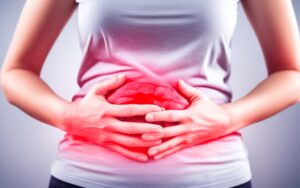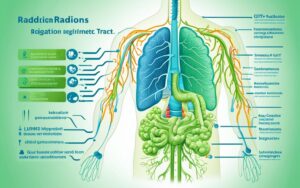
In this section, we will explore the causes of bile acid malabsorption (B.A.M) and its impact on digestion. occurs when the body fails to properly absorb bile acids, leading to digestive issues and discomfort. These bile acids are produced by the liver and play a crucial role in breaking down fats in the small intestine.
When BAM occurs, the unabsorbed bile acids travel through the digestive system and can reach the colon. Once in the colon, they can cause irritation and lead to symptoms like diarrhea, abdominal pain, and bloating.
The exact c can vary. In some cases, it may be a result of certain medical conditions, such as Crohn’s disease, celiac disease, or chronic pancreatitis. It can also be caused by previous surgeries involving the digestive system, such as gallbladder removal.
Understanding is essential for individuals experiencing digestive issues. By identifying the underlying factors, healthcare professionals can recommend appropriate treatment and management strategies to improve the quality of life for those affected.
Key Takeaways:
- Bile acid malabsorption occurs when the body fails to properly absorb bile acids, leading to digestive issues.
- Common symptoms include diarrhea, abdominal pain, and bloating.
- Causes can range from medical conditions to previous surgeries involving the digestive system.
- Understanding the causes is crucial for effective treatment and management strategies.
What is Bile Acid Malabsorption?
Bile acid malabsorption is a digestive disorder characterized by impaired absorption of bile acids in the intestines. Bile acids play a crucial role in the digestion and absorption of fats. They are produced by the liver and stored in the gallbladder. When food reaches the small intestine, bile acids are released into the digestive tract to help break down fats into smaller molecules, making them easier to absorb.
However, in individuals with bile acid malabsorption, the process of absorbing bile acids is disrupted. This can occur due to various factors such as impaired bile acid transporters, inflammation of the intestines, or certain medical conditions. The exact causes of BAM are still being studied, but it is believed to have a multifactorial nature.
One of the primary causes is a condition known as primary bile acid diarrhea, which leads to excessive production of bile acids and overwhelms the absorptive capacity of the intestines. This can result in increased levels of bile acids in the colon, leading to symptoms such as diarrhea, abdominal pain, and bloating.
Bile Acids and Digestion
Bile acids play a critical role in the digestion and absorption of dietary fats. They emulsify fat molecules, breaking them down into smaller particles that can be more easily digested and absorbed by the body. Bile acids also aid in the absorption of fat-soluble vitamins, such as vitamins A, D, E, and K.
When bile acid malabsorption occurs, the disrupted absorption of bile acids can lead to a range of digestive symptoms. These symptoms can vary in severity and may include frequent loose stools, urgency to have a bowel movement, abdominal discomfort, and bloating.
“Bile acid malabsorption can significantly impact daily life, causing discomfort and disruptions in bowel habits.”
If left untreated, it can lead to malnutrition and nutrient deficiencies. It is crucial to identify and address the underlying causes of bile acid malabsorption to effectively manage the condition and improve digestive health.
Symptoms
(B.A.M) can manifest in various symptoms that can significantly impact an individual’s daily life. It’s important to be aware of these symptoms in order to seek appropriate treatment and management strategies. Below, we outline the common symptoms experienced by individuals with bile acid malabsorption:
- Chronic diarrhea: One of the primary symptoms of bile acid malabsorption is chronic diarrhea, which can occur without warning and be difficult to control. This diarrhea is typically watery and may be accompanied by urgency and abdominal cramps.
- Abdominal pain and discomfort: Many individuals experience ongoing abdominal pain and discomfort, which can range from mild to severe. This pain is often described as a burning sensation or cramping in the lower abdomen.
- Bloating and gas: BAM can lead to increased gas production, resulting in bloating and discomfort. Individuals may also experience frequent belching or passing of gas.
- Steatorrhea: Due to poor absorption of bile acids, individuals may also have greasy or oily stools, known as steatorrhea. These stools may appear pale in color and have a foul smell.
- Weight loss: In some cases, can lead to unintentional weight loss. This can occur due to the malabsorption of essential nutrients and the impact on overall digestion and metabolism.
- Fatigue: The chronic nature of bile acid malabsorption and its impact on digestion can leave individuals feeling fatigued and lacking in energy.
- Nutritional deficiencies: Over time, can result in nutritional deficiencies, as essential vitamins and minerals are not properly absorbed by the body.
It’s important to note that the severity and combination of these symptoms can vary from person to person. If you are experiencing one or more of these symptoms, it is advisable to seek medical attention for proper diagnosis and treatment.
In the next section, we will explore the diagnostic methods used to identify bile acid malabsorption and how healthcare professionals can effectively diagnose this condition.
Diagnosis
In order to accurately diagnose, healthcare professionals utilize a variety of tests and procedures to confirm the presence of this condition. These diagnostic methods help determine the underlying cause of digestive issues and guide appropriate treatment plans.
One commonly used test for diagnosing bile acid malabsorption is the SeHCAT (selenium-75 homocholic acid taurine) scan. During this procedure, a small amount of radioactive substance is ingested, and specialized imaging is used to track the movement of bile acids through the digestive system. This test provides valuable information about the absorption and retention of bile acids, helping to identify malabsorption.
Another diagnostic method is stool collection and analysis. By examining the composition of stool, healthcare providers can identify the presence of excess bile acids, fat, and unabsorbed carbohydrates. This analysis helps pinpoint the cause of digestive symptoms and determine if BAM is contributing to the issues.
Additionally, healthcare professionals may perform a blood test to measure levels of 7-alpha-hydroxy-4-cholesten-3-one (C4) and fibroblast growth factor 19 (FGF19). Elevated levels of C4 and decreased levels of FGF19 can indicate bile acid malabsorption and aid in diagnosis.
Overall, a comprehensive approach to diagnosis, which may include a combination of imaging, stool analysis, and blood tests, allows healthcare professionals to accurately identify and confirm BAM. This ensures that appropriate treatment strategies can be implemented to alleviate symptoms and improve overall digestive health.
Diagnostic Methods
| Diagnostic Method | Description |
|---|---|
| SeHCAT scan | A radioactive substance is ingested to track the movement of bile acids through the digestive system |
| Stool collection and analysis | Examination of stool composition to identify excess bile acids, fat, and unabsorbed carbohydrates |
| Blood test | Measuring levels of C4 and FGF19 to indicate bile acid malabsorption |
Treatment Options
When it comes to managing bile acid malabsorption, there are various treatment options available that aim to alleviate symptoms and improve overall well-being. Treatment approaches may include dietary changes, medications, and other interventions tailored to individual needs.
Dietary Modifications
One of the primary strategies for treating BAM is adopting a specific diet that helps regulate the digestion and absorption of bile acids. This may involve:
- Reducing intake of foods high in fat, as fats can stimulate bile acid production and exacerbate symptoms.
- Incorporating soluble fibers into the diet, such as fruits, vegetables, and whole grains, which can bind to bile acids and promote their elimination.
- Avoiding trigger foods that are known to worsen symptoms, such as spicy foods or caffeine.
Medications
In some cases, healthcare professionals may prescribe medications to help manage bile acid malabsorption. These medications can help regulate the production and reabsorption of bile acids in the digestive system, reducing the severity of symptoms. Commonly prescribed medications include:
| Medication | Function |
|---|---|
| Bile acid sequestrants | Work by binding to bile acids in the intestines, preventing their reabsorption and promoting their elimination. |
| Probiotics | Involve the use of beneficial bacteria to restore gut health and improve digestion. |
| Antidiarrheal medications | Help control diarrhea symptoms associated with bile acid malabsorption. |
Other Interventions
In addition to dietary modifications and medications, there are other interventions that individuals with bile acid malabsorption may find beneficial:
- Supplementing with fat-soluble vitamins, such as vitamins A, D, E, and K, as these may be poorly absorbed due to impaired bile acid function.
- Engaging in regular exercise, which can help regulate bowel movements and promote overall digestive health.
- Managing stress levels, as stress has been shown to affect digestion and worsen symptoms.
It’s important to note that treatment plans should be personalized to each individual, taking into consideration their specific symptoms, medical history, and lifestyle factors. Consulting with a healthcare professional is crucial to determine the most appropriate treatment options and ensure optimal management .
Managing BAM
When it comes to managing a balanced diet plays a crucial role. By making strategic dietary choices, individuals can help alleviate symptoms and improve their overall digestive health. Additionally, certain supplements can provide added support in managing bile acid malabsorption.
The Bile Acid Malabsorption Diet
Following a bile acid malabsorption diet can help minimize digestive issues and promote better nutrient absorption. Here are some key dietary considerations:
- Avoiding high-fat foods: Consuming excessive amounts of fatty foods can exacerbate symptoms . Opt for low-fat options instead.
- Incorporating soluble fiber: Soluble fiber can help bind excess bile acids, reducing their impact on the digestive system. Foods rich in soluble fiber include oatmeal, fruits, and vegetables.
- Limiting caffeine and alcohol: Both caffeine and alcohol can stimulate the production of bile, potentially worsening symptoms. Moderating consumption is advised.
- Staying hydrated: Drinking plenty of water helps maintain healthy digestion and supports overall gut health. Aim for at least eight glasses of water per day.
Bile Acid Malabsorption Supplements
In addition to dietary modifications, certain supplements can assist in managing bile acid malabsorption. These supplements are specifically designed to support digestion and provide relief from symptoms. Some commonly recommended supplements include:
- Bile Acid Sequestrants: These supplements bind to excess bile acids in the gut, preventing their reabsorption and reducing symptoms.
- Pancreatic Enzymes: Pancreatic enzymes aid in the breakdown and absorption of nutrients, helping to alleviate digestive discomfort.
- Probiotics: Probiotic supplements promote a healthy gut microbiome, which can aid in digestion and reduce symptoms of bile acid malabsorption.
Remember to consult with a healthcare professional before starting any new supplements to ensure they are suitable for your individual needs.
Incorporating these dietary strategies and supplements into your routine can help effectively manage and improve your quality of life. If you have any questions or concerns, it is always best to consult with a healthcare professional for personalized guidance.
The Impact of Bile Acid Malabsorption on Digestion
Bile acid malabsorption can have a significant impact on digestion, leading to various symptoms and conditions such as bile acid diarrhea. When the body fails to properly absorb bile acids, it disrupts the normal digestive process and can cause discomfort and inconvenience for individuals affected by this condition.
Bile acid diarrhea is a common consequence of bile acid malabsorption. Excess bile acids in the intestines can speed up bowel movements and result in watery stools. This can lead to frequent and uncontrollable urges to use the bathroom, significantly affecting one’s quality of life.
It is important to understand that bile acid diarrhea is a distinct condition associated with bile acid malabsorption, and its symptoms can be different from other types of diarrhea. Individuals experiencing bile acid diarrhea may have increased urgency and frequency of bowel movements, as well as loose and watery stools.
The connection between BAM and bile acid diarrhea underscores the importance of addressing the underlying cause. By effectively managing bile acid malabsorption, individuals can alleviate symptoms and improve their digestion.
Next, we’ll explore the various treatment options available, focusing on strategies that can help individuals regain control over their digestive health.
Common Symptoms of Bile Acid Diarrhea
| Symptoms | Description |
|---|---|
| Watery stools | Stools that are loose, liquid-like, and difficult to control. |
| Increased urgency | A feeling of needing to have a bowel movement urgently and without warning. |
| Frequency | Having more bowel movements than usual, often multiple times a day. |
| Abdominal discomfort | Cramping, bloating, or pain in the abdominal region. |
| Weight loss | Unintentional weight loss due to malabsorption of nutrients. |
Conclusion
In conclusion, this article has provided an insightful overview of (B.A.M), shedding light on its causes, symptoms, diagnosis, treatment options, and management strategies. By understanding the intricacies of this condition, individuals can empower themselves to take proactive steps towards better digestive health and overall well-being.
Bile acid malabsorption occurs when the body fails to properly absorb bile acids, essential for the digestion and absorption of fats. This can lead to a range of symptoms, including frequent diarrhea, abdominal pain, and malnutrition. By recognizing these symptoms and seeking appropriate medical help, individuals can receive an accurate diagnosis.
Once diagnosed, various treatment options are available to manage bile acid malabsorption. These include dietary changes, such as reducing fat intake and avoiding trigger foods, as well as medications that can help regulate the production and absorption of bile acids. Additionally, the use of supportive supplements, under medical guidance, can be beneficial in maintaining optimal digestive function.
Managing BAM requires a holistic approach that extends beyond treatment. Adopting a well-balanced diet, rich in fiber and easily digestible foods, can provide relief and support digestive health. It is also essential to maintain regular communication with healthcare professionals to monitor symptoms, adjust treatment plans if necessary, and ensure ongoing management.
By staying informed and adhering to a comprehensive treatment and management plan, individuals can reclaim control over their digestive health. Consulting with healthcare professionals and seeking support from registered dietitians play key roles in finding personalized strategies to mitigate symptoms and improve overall well-being.











